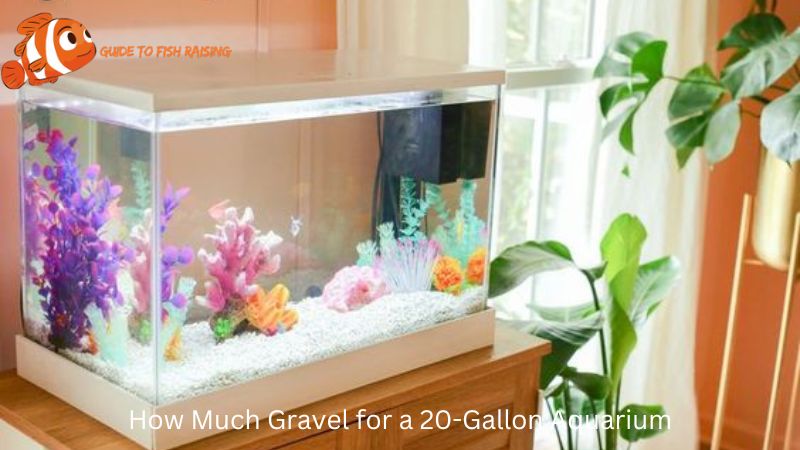Aquariums and Fish Tanks
How Much Gravel for a 20-Gallon Aquarium
How Much Gravel for a 20-Gallon Aquarium? Gravel in aquariums serves not only as a decorative element but also plays a crucial role in maintaining a healthy aquatic environment. Whether you’re setting up a new aquarium or refreshing an existing one, choosing the right amount of gravel is essential for optimal fish health and aquarium maintenance.
In this guide, Guide to Fish Raising will explore the importance of aquarium gravel, discuss different types available, provide a step-by-step method to calculate the amount needed for a 20-gallon tank, offer practical tips for usage, and highlight maintenance considerations.
Why Gravel Matters
Aquarium gravel is more than just a substrate; it’s a vital component that impacts both the aesthetic appeal and functionality of your aquarium ecosystem.
Biological Filtration
One of the most critical roles of aquarium gravel is its contribution to biological filtration. Gravel provides a vast surface area where beneficial bacteria, known as nitrifying bacteria, can thrive and colonize. These bacteria are essential for the nitrogen cycle, a natural process crucial for maintaining water quality in your aquarium.
- Nitrogen Cycle: Ammonia, produced by fish waste and decaying organic matter, is highly toxic to fish. Nitrifying bacteria residing in the gravel convert ammonia into nitrites and then into nitrates, which are less harmful to aquatic life. This process, known as biological filtration, is vital for keeping ammonia levels in check and ensuring a healthy environment for your fish.
Aesthetic Appeal
Aquarium gravel is available in a wide range of colors, sizes, and textures, allowing aquarists to create diverse and visually appealing underwater landscapes:
- Natural Look: Natural gravel varieties mimic riverbeds or lake bottoms, providing a realistic habitat for fish and enhancing the overall aesthetic of the aquarium.
- Color Variety: Colored gravel options, from vibrant blues to earthy tones, enable aquarists to design themed aquariums or match gravel with specific décor elements. This customization adds depth and visual interest to the tank.
Plant Growth
In planted aquariums, gravel plays a crucial role in supporting aquatic plant life:
- Rooting Medium: Gravel provides a stable medium for plant roots to anchor and spread. This anchorage is essential for preventing plants from uprooting due to fish activities or water currents.
- Nutrient Exchange: Plant roots absorb essential nutrients, such as nitrogen, phosphorus, and potassium, directly from the gravel substrate. The gravel also acts as a reservoir for root fertilizers and supplements, promoting healthy growth and vibrant foliage.
Fish Comfort
Choosing the right type and depth of gravel can significantly impact the well-being of your fish:
- Natural Habitat: Many fish species are accustomed to habitats with a gravel substrate. Providing a familiar environment reduces stress levels and encourages natural behaviors, such as foraging and digging.
- Behavioral Benefits: Bottom-dwelling fish species, like corydoras or loaches, sift through gravel in search of food. A gravel substrate allows these fish to exhibit their natural behaviors, contributing to their overall health and happiness.
- Preventing Injury: Smooth, rounded gravel minimizes the risk of injury to delicate fish fins and barbels. Sharp or abrasive substrates should be avoided, especially in tanks housing sensitive fish species.
Types of Aquarium Gravel

Aquarium gravel is available in several varieties, each suited to different aquarium setups and aesthetic preferences:
Natural Gravel
Description: Natural gravel is typically inert and composed of river rocks or similar materials. It comes in a variety of colors and sizes, ranging from fine gravel to larger pebbles.
Benefits:
- Aesthetic Appeal: Provides a natural look that mimics riverbeds or lake bottoms, creating a realistic habitat for fish.
- Versatility: Suitable for most freshwater aquariums, including community tanks and species-specific setups.
- Ease of Use: Does not alter water chemistry, making it low-maintenance and beginner-friendly.
Considerations:
- Size Selection: Choose gravel size based on fish species; smaller gravel is preferable for fish that sift through substrate.
Colored Gravel
Description: Colored gravel is dyed to achieve vibrant hues, enhancing the visual appeal of aquariums.
Benefits:
- Customization: Allows aquarists to create themed aquariums or match gravel with specific décor elements.
- Attractive Displays: Adds depth and contrast to aquarium landscapes, making fish and plants stand out.
Considerations:
- Dye Stability: Ensure the dye used is aquarium-safe and won’t leach harmful chemicals into the water.
- Maintenance: Colored gravel may fade over time and may require periodic replacement to maintain aesthetics.
Specialty Gravel
Description: Specialty gravel is designed with specific aquarium needs in mind, offering enhanced properties tailored to certain setups.
Examples:
- Planted Tank Substrate: Includes gravel with increased porosity or nutrient-rich additives to support plant growth.
- Cichlid Substrate: May feature coarse gravel or even crushed coral to create a higher pH environment preferred by cichlids.
Benefits:
- Functionality: Specialty gravel addresses specific water chemistry or habitat requirements for certain fish or plants.
- Long-Term Benefits: Enhances water quality, promotes plant health, or supports the natural behaviors of specific fish species.
Considerations:
- Compatibility: Choose gravel that aligns with the needs of your aquatic inhabitants, ensuring compatibility with other tank elements.
Substrates
Description: Beyond gravel, substrates like sand or soil cater to specialized aquarium setups, particularly planted tanks.
Examples:
- Aquarium Sand: Fine-grained sand creates a sleek, modern look and is ideal for bottom-dwelling fish that sift through substrate.
- Planting Soil: Nutrient-rich soil substrates promote robust plant growth by providing essential nutrients directly to roots.
Benefits:
- Plant Health: Supports root development, nutrient uptake, and overall plant vitality.
- Aquascape Design: Allows for intricate landscaping and planting arrangements in advanced aquascaping setups.
Considerations:
- Maintenance: Some substrates may require careful maintenance to prevent compaction or nutrient imbalance.
- Compatibility: Integrate substrates thoughtfully to ensure they meet the needs of both plants and fish in the aquarium ecosystem.
Calculating Gravel Amount for a 20-Gallon Tank
Tips for Using Gravel in Aquariums
To ensure the best results with your aquarium gravel, follow these practical tips:
Rinsing Gravel
Before adding gravel to your aquarium, it’s crucial to rinse it thoroughly under running water. This process removes fine dust and debris that can cloud the water and potentially harm your fish.
- Method: Place the gravel in a bucket or colander and rinse it until the water runs clear. Stir the gravel gently with your hand to dislodge any trapped particles.
Layering
Once rinsed, spread the gravel evenly across the tank bottom to achieve a uniform depth. Avoid creating uneven patches or mounds that can disrupt the aesthetic appeal and create debris traps.
- Even Distribution: Use a clean hand or a flat tool to distribute the gravel evenly. Smooth out any noticeable mounds to maintain a consistent appearance.
Depth Consideration
For most aquarium setups, aim for a gravel depth of 1.5 to 2 inches (3.8 to 5 cm). This depth strikes a balance between providing sufficient surface area for beneficial bacteria and allowing plant roots to penetrate.
- Biological Filtration: Adequate gravel depth supports the colonization of beneficial bacteria, crucial for biological filtration and maintaining water quality.
- Plant Health: Deep enough gravel allows plant roots to anchor securely and access nutrients. Ensure that plant roots can penetrate the gravel layer without difficulty.
Combining with Substrates
In planted tanks or specialized setups, consider layering gravel over other substrates like nutrient-rich soil or sand to cater to specific plant and fish needs.
- Nutrient-rich Substrates: Use specialized substrates like planting soil beneath gravel to promote robust plant growth. These substrates provide essential nutrients and support root development.
- Sand Areas: Integrate sand in specific areas for aesthetic contrast or to create zones suitable for bottom-dwelling fish that sift through substrate.
Additional Tips
- Maintenance Routine: Regularly vacuum the gravel surface during water changes to remove accumulated debris and prevent nutrient buildup. Use a gravel vacuum or siphon to clean without disturbing the substrate layers excessively.
- Avoid Disturbance: Minimize disruption to the gravel bed during maintenance to preserve the beneficial bacteria colonies and maintain water clarity.
Maintenance and Cleaning
Proper maintenance of gravel contributes to the overall health of your aquarium:
Regular Vacuuming
Regularly vacuuming the gravel helps remove debris, uneaten food, and fish waste that accumulate on the substrate surface:
- During Water Changes: Use a gravel vacuum or siphon to clean the gravel while performing regular water changes. Insert the vacuum into the gravel and move it across the substrate to lift debris without disturbing the gravel bed excessively.
- Frequency: Aim to vacuum the gravel every 1-2 weeks, or as needed based on the amount of waste present and your tank’s bio-load.
Avoiding Disturbance
When cleaning the gravel, take care to minimize disturbance to the substrate layers and the tank ecosystem:
- Gentle Cleaning: Avoid digging deeply into the gravel bed. Instead, gently hover the vacuum above the gravel to lift debris without disturbing the beneficial bacteria colonies residing within.
- Maintain Water Clarity: Excessive disturbance can cloud the water temporarily, but gentle cleaning minimizes this effect and preserves water clarity.
Replacing Gravel
Over time, aquarium gravel may become soiled or break down, affecting its appearance and functionality. Consider gradual replacement to maintain water quality and the health of your aquarium:
- Assessment: Periodically assess the condition of your gravel. If it appears excessively dirty or starts to break down, it may be time to replace some or all of it.
- Gradual Replacement: Replace gravel in sections during major tank maintenance or when performing substrate upgrades. Remove old gravel carefully to avoid disturbing the tank’s balance and replace with rinsed and treated gravel to prevent introducing contaminants.
- Water Preparation: Before adding new gravel, rinse it thoroughly to remove dust and debris. Treat with a dechlorinator if necessary to ensure it’s safe for aquatic life.
Conclusion
Summarize the importance of choosing the right amount of gravel for a 20-gallon aquarium to maintain water quality, support plant growth, and ensure fish health. Encourage readers to consider their specific aquarium setup and fish needs when selecting gravel types and quantities.





